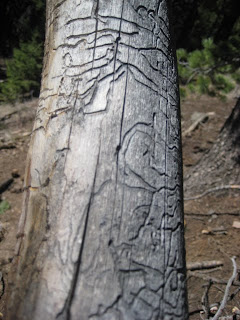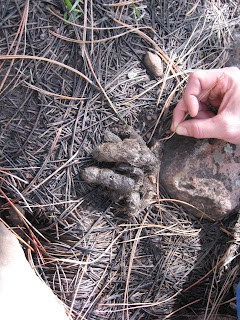Distance: 3.4 miles
Altitude Gained: 220 ft.
High Point: 8370 ft.
a mere woodland stroll
easy like sunday morning
picnic by the lake
Forebay Lake is a picnic hike, a walk in the woods. There are actually three lakes to see: you drive by Haviland just before the trailhead; you walk by a small unnamed lagoon; and the trail more or less ends near Forebay.
Let's call the unnamed lake Damselfly Reservoir.
There were a ton of dragonflies and damselflies; both insects lay their eggs in the water so this makes sense. Together they comprise the Insecta class Odonata which means toothed-jaw and they are aerial predators; they buzzed around us the whole hike with expert skill chomping pesky mosquitos and flies. Well actually, the dragonfly is the true master compared to the smaller weaker damselfly. Distinguishing the two insects is easy. When at rest, the damselfly holds its wings parallel to and flattened to the body while the dragonfly rests with its wings perpendicular to the body.
This is a Four-spotted skimmer (Libellula quadrimaculata) that we saw by the lake. These dragonflies are such professionals in the air that they even mate in flight.
This damselfly below is the common blue tail (Ischnura heterostecta). These damselflies may not mate in the air but they configure into a lovely heart-like copulation pose!
http://sites.butler-bremer.com/web/kladage/iwild3431%20Mating%20Blue%20Damsel%20Flies.jpg
We are mildly confused by a few discrepancies we found in Pixler's (and Peel's) description of this hike. First, we never had to ford Elbert Creek or anything like it. According to the book, we would have been able to do this without getting wet by crossing at the waterfall using available logs. What? Where? Wet? Waterfall? Logs? Did we miss a new bridge somewhere? The part immediately following was familiar enough: shortcut through the meadow under a power line, big water pipe, metal tower over the lake. Yes, yes, and yes. But what is this about a bluff southeast of the lake from which one can see the Animas River and potentially the train at the right time of day. We explored southeast and every other direction for that matter: no such bluff, no such views. We did see a gate at the the end of the trail with a "Danger Keep Out" sign posted that is never mentioned in the book. Was the bluff supposed to be that way? Didn't seem like it went toward any views.
Nevertheless, the walk in the woods was worth it. We did have a picnic at the lake, a pretty view in its own right. This is a good hike for anyone, kids and grandparents alike. A walk in the woods if you are camping at Haviland Lake or have a few hours to go strolling to a nice picnic site.



























































